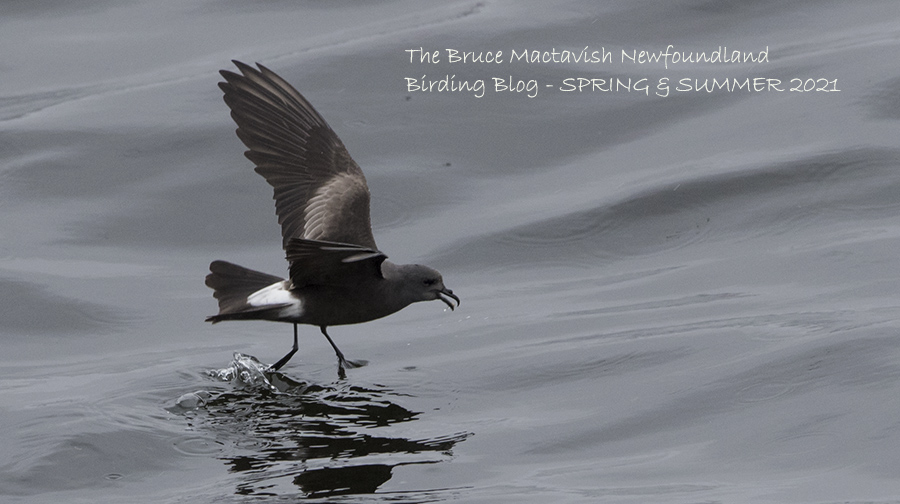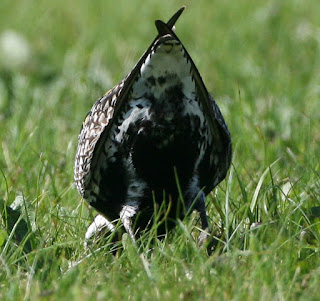When jailed on a seismic vessel on the Grand Banks for the
foggy month of July you have a lot of time to read. This month I’ve been digging into the new book
Rare Birds of North America by Howell, Lewington & Russell (Princeton
University Press, 2014). The book is a collection
of accounts of North American rarities occurring < 5 times per year since
1950. The species accounts (262 species
covered) list or summarise the North American occurrences depending on the
number of records. The records are analyzed for seasonal and spatial patterns with
explanations offered for why they exist and what to expect in the future. Each species account includes a fully detailed
section on identification including illustrations by Ian Lewington. The lavish
illustrations are beautiful to look at besides being accurate and
informative. All the plumages likely to
be encountered in North America are included.
The 40 page introduction to the book describes current
thoughts and brings to light less well known ideas on bird vagrancy to North
America. Clearly written and easy to
understand facts and ideas are explained and backed up with visual aids in the
form of global maps making it easier to picture how birds might travel from one
continent to the next. Even the use of the word vagrancy is discussed. It is great to have all these ideas, some having
been tossed around over the years, all in one place. The book is a definitely a
keeper for hard core vagrant hunters but also useful for average intensity
birders. For instance I found the book
useful this spring for looking up the North American occurrences of Little
Egret and Garganey. It summarizes the records of these relatively regular vagrant
species and gives explanations with the best evidence available, on the likely
routes of their journey from the other side of the Atlantic to North America and
eventually to Newfoundland. It makes
sense out the strong west, not east, winds that immediately preceded the
sighting of both birds.
While the book does not deal directly with why we find
southern warblers in the Avalon alders in September, you can build your own
ideas by reading about drift migrants.
How migrating birds that find themselves over a large body of water and
getting low fuel reserves on board may take the most energy efficient route to
safety which is flying with the wind. Little did they know how far away
Newfoundland was when they made that move! But in nutshell this is why we Avaloners
yearn for SW winds during September and October hoping for those strays
originating from the eastern US.
Pacific Golden Plover (PGPL) is not covered by the book
because it breeds in Alaska. There are
only a handful of records for eastern North America. Newfoundland has three
records:
- 27-28 June & 9-15 July 2007 (Trepassey)
- 6-8 June 2010 (Cape Race)
- 30 July-3 August 2011 (Bellevue Beach)
Using theories outlined in this book one can form a picture
of how PGPL could have happened in Newfoundland. There is the mirror-image migration theory. A
misorientation where birds leaving breeding grounds in Alaska and intending to
fly southwest for a long distance to reach wintering grounds in the western
Pacific and Australia actually fly southeastward for an equally long distance. SE
is the mirror-image of SW. The course
changed but the programmed distance was similar. This simplified theory is a plausible explanation
for the Trepassey and Bellevue records which occurred during ‘fall’ migration. But how do we explain the spring PGPL record
from Cape Race. Possibly it was a bird
(even the same bird as Trepassey three years earlier!?) that had migrated south
on a mirror-image misorientation and ended up wintering in eastern North
America and in spring was retracing steps back to Alaskan breeding
grounds.
Considering the huge rarity factor of PGPL in eastern North
America it is conceivable that the three Newfoundland records involve just one
bird, though the Bellevue bird appeared to be a female and the Trepassey and
Cape Race birds looked like males. The
three records fall within a five year period and are all on the Avalon
Peninsula. Time will tell if a pattern
of July records materializes.
There is another example of an Alaska-type shorebird reaching
Newfoundland in July and then appearing in the following spring. The Bar-tailed
Godwit at Stephenville Crossing in July 2005 had barred underwings coverts
marking it as baueri the race
breeding in Alaska and Siberia. The
following spring on 5 June a Bar-tailed Godwit appeared at Stephenville
Crossing. The underwings were not observed but bird looked the same and considering
how rare it is in Newfoundland there was a high probability it was the same
bird retracing its mirror-image misorientated fall migration route from the
year before.
A vague pattern is developing. Newfoundland can get long
distant migrant Alaskan breeding shorebirds.
Another long distant migrant shorebird nesting in Alaska with a similar
migration route to PGPL and baueri
Bar-tailed Godwit is Rufous-necked Stint.
There already is a light pattern of July occurrences in the northeastern
United States. In July Rufous-necked
Stints are still in breeding colours, not to be confused with Sanderlings
retaining breeding orange around the face and breast in July. A Rufous-necked Stint is a bird to be aware
of when shorebirding in July. July is
NOW!
Pacific Golden Plover at Trepassey, Avalon Peninsula, Newfoundland on 27 June 2007
Pacific Golden Plover at Cape Race, Avalon Peninsula, Newfoundland on 7 June 2010 sheltering out of lashing wind and rain outside drivers car window. Same bird as Trepassey bird three years earlier???
Bar-tailed Godwit at Stephenville Crossing, western Newfoundland 13 July 2005. The barred underwings are characteristic of the subspecies baueri which breeds in western Alaska and northern Russia.
Bar-tailed Godwit at Stephenville Crossing on 5 June 2006. Same bird as present the July 2007?? Perhaps retracing its southward migration back to Alaska?

























